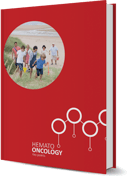DLBCL is the most common form of non-Hodgkin’s lymphoma (NHL), constituting 30% to 58% of lymphoma cases.
DLBCL treatments vary according to prognosis. The criteria used are the IPI (International Prognostic Index), gene expression profile and molecular factors characterized by immunohistochemistry. It is crucial that a treatment regime is decided upon as quickly as possible. Chemotherapy and immunotherapy are currently the main DLBCL treatment options with the most positive outcomes.

1st Line Treatments
The most widely used 1st line DLBCL treatment is currently the combination known as R-CHOP (Rituximab, cyclophosphamide, doxorubicin hydrochloride, vincristine sulfate, prednisone). Occasionally, an additional chemotherapy drug, etoposide phosphate, is added to the R-CHOP regimen, resulting in a drug combination called R-CHOEP. In France, RACBVP is also frequently used (rituximab, doxorubicin, cyclophosphamide, vindesine, bleomycin, prednisone).
In Germany, nearly one third of patients are also treated with radiation therapy in addition to chemotherapy drugs.
2nd Line Treatments (R/R)
For relapsed patients or those for whom R-CHOP is ineffective (R/R), high-dose chemo- therapy followed by stem cell transplantation can be used.
R-DHAP (Rituximab, dexamethasone, high-dose ara-C, platinol (cisplatin)) and R-BENDA (Rituximab, bendamustine) are the most often prescribed 2nd-line regimens followed by R-ESHAP (Rituximab, etoposide, solumedrol, high-dose ara-C, platinol), R-CHOP and R-GEMOX (Rituximab, gemcitabine, oxaliplatin), R-ICE (Rituximab, ifosfamide, carboplatin, etoposide) and R-GDP according to country. Together, these regimens account for around 2/3 of all 2nd-line regimens.
3rd Line Treatments
R-EPOCH, R-GEMOX and R-BENDA account for around 1/3 of all regimens used in 3rd-line treatments.
DLBCL Treatments in Development
Many DLBCL treatments are currently in clinical trials. A few of these therapies target naïve patients, but most concern relapsed/refractory (R/R) patients. Among the drugs tested, we find: Alisertib (MLN3237), RevlimidTM (lenalidomide), BlincytoTM (blinatumumab), OpdivoTM (nivolumab), the combination BlincytoTM KeytrudaTM,
MOR-208, Chimeric antigen receptor therapy (CAR-T), FarydakTM (panobinostat), AfinitorTM (everolismus), ZolinzaTM (vorinostat) and Ibrutinib (Imbruvica).
These clinical studies examine different use situations (1st line, maintenance, etc.) and different types of patients (newly diagnosed patients, relapsed or refractory patients, elderly subjects, patients belonging to a specific molecular subgroup, etc.) to determine the best use of these treatment options.
Our latest social media listening study on the DLBCL patient journey is available to purchase now.

DLBCL is the most common form of non-Hodgkin’s lymphomas (NHL), constituting 30% to 58% of lymphoma cases. Treatments vary according to prognosis, it is crucial that a regimen is decided upon as quickly as possible.
Download our free eBook here for a high-level overview:


You might also be interested in:
Enhancing Traditional Research Methods with Social Media Listening
Sources:
- AplusA DLBCL syndicated research accross EU, North America Japan and China 2018